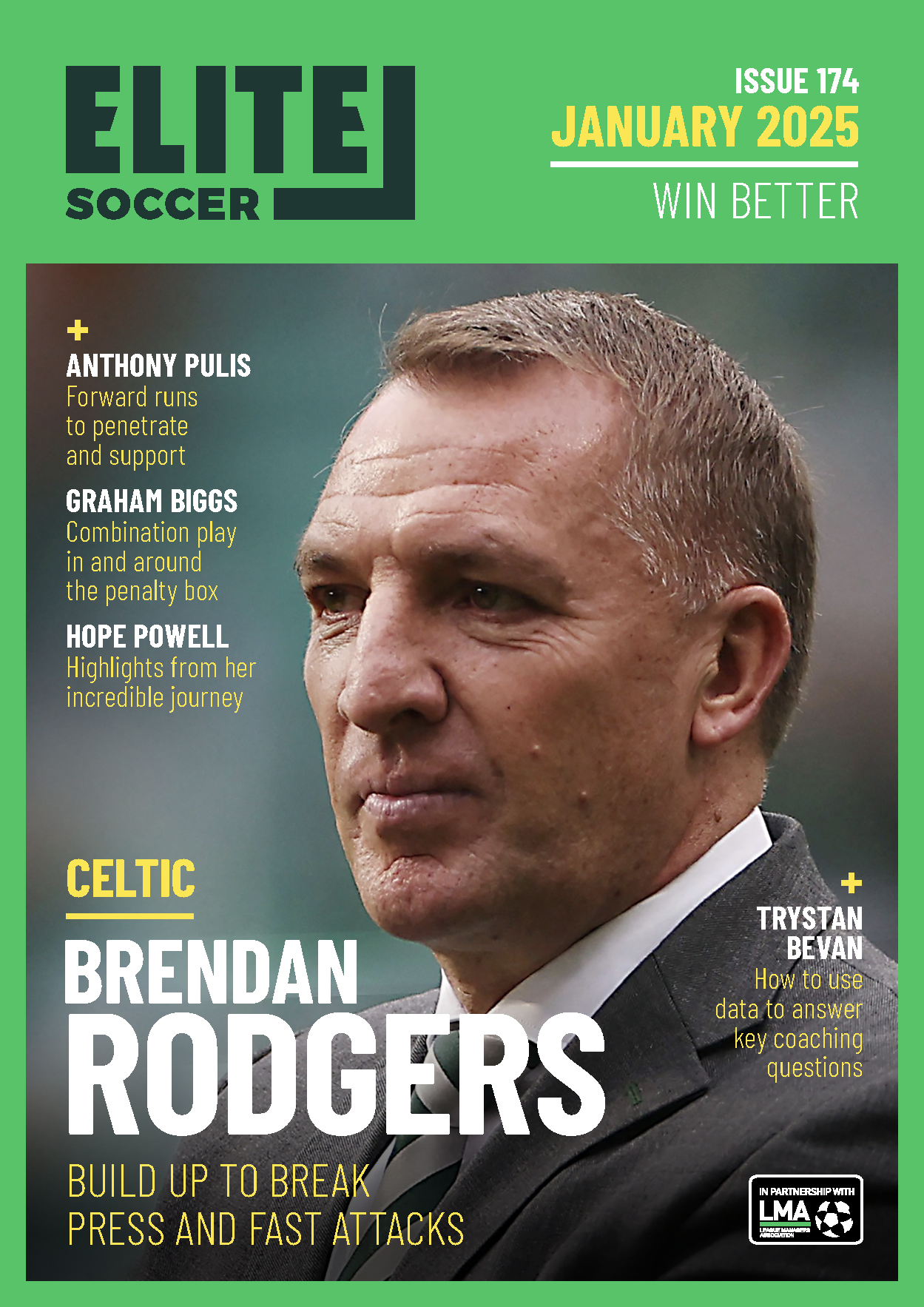You are viewing 1 of your 1 free articles
Pressing as a unit
This session is used throughout the season, particularly when there is a rest from the intense fixture schedule. It’s great for enabling players to top up on their fitness, but also practises aspects of technical and tactical play, as well as rehearsing good communication between players.
| Area | Full pitch |
| Equipment | Balls, goals |
| No. of Players | 24 |
| Session Time |
30mins, comprised of 4-5mins rotations in pre-season, or 1-2mins during season time |
This session is used throughout the season, particularly when there is a rest from the intense fixture schedule. It’s great for enabling players to top up on their fitness, but also practises aspects of technical and tactical play, as well as rehearsing good communication between players.
We find players enjoy the session because, despite being physically demanding, it’s game-based, fast and fun.
Pressing as a team is hard work, but done well it is one of the cornerstones of success in football.
What do I get the players to do?
Circular possession
Players set up in a circle between the two penalty areas, as shown – 12 forming the circle with six defenders working inside to press the ball.
The coach starts the session by playing the ball to any man on the outside of the circle. This is the trigger for the team in the middle to press, as a group. This must be done by the whole team (1a).
1a
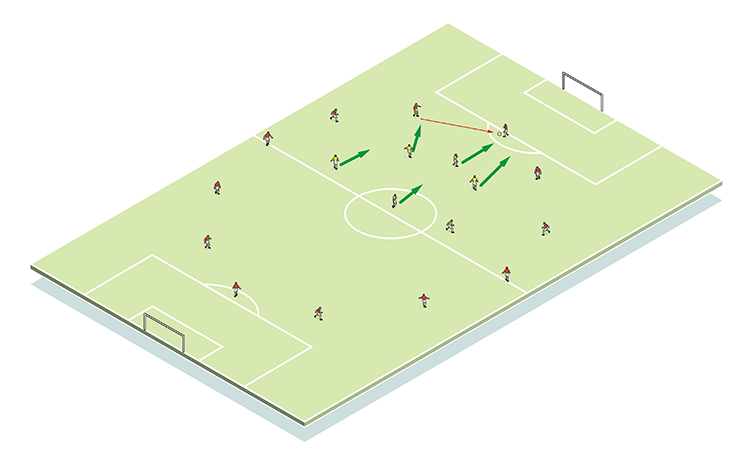
Players must retain this pressure on the ball, with players in the circle passing it around the edge or spreading longer balls across, but always with the aim of retaining possession (1b). If defenders win the ball through successfully pressing, it’s passed to the coach, who plays a new ball in to keep the session live.
1b
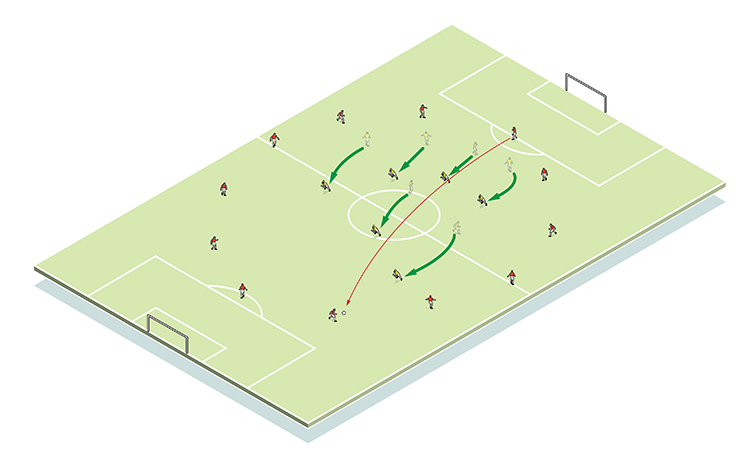
In terms of scoring, the pressing team must win as many balls back as possible in the allocated time. Alternatively, we can count the number of consecutive passes - resetting back to zero when the ball is won back – or simply the total number of passes completed.
When each team has pressed, accumulate scores, with the lowest scoring having to perform a forfeit.
How do I progress the session?
Varying the number of touches allowed provides a useful progression tool, from all-in to one-touch passing.
Circular possession plus target men
To advance the game, we add a target man in each half, which the ‘circle’ team can use (2a). This serves to increase options for the man on the ball, and creates another problem for the chasing team to solve since, in essence, they have an ‘enemy’ in their ranks.
2a
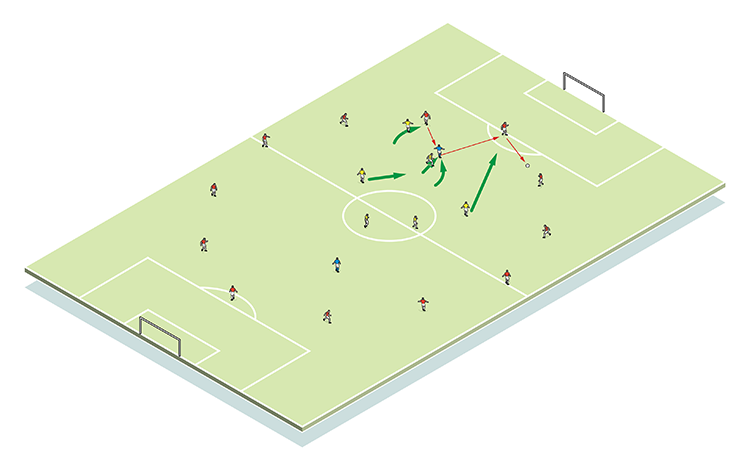
We can add a few conditions where the target men are concerned. For instance, players can only use the target man in their own half, or it can be compulsory that the target man must be utilised before the ball can be played across to the other side of the circle. Alternatively, allow players to use either target man (2b), or instruct that the target man is the only player who can switch play to the other side of the circle.
2b

And of course, any other conditions that the coach deems appropriate can be introduced.
Circular possession with target men and keepers
As a final challenge, we add another target man in each half plus a goalkeeper in each 18-yard box. The keeper now works just as he would in a game, being on his toes and ready to receive the ball back should, for instance, a defender find himself closed down (3a).
3a
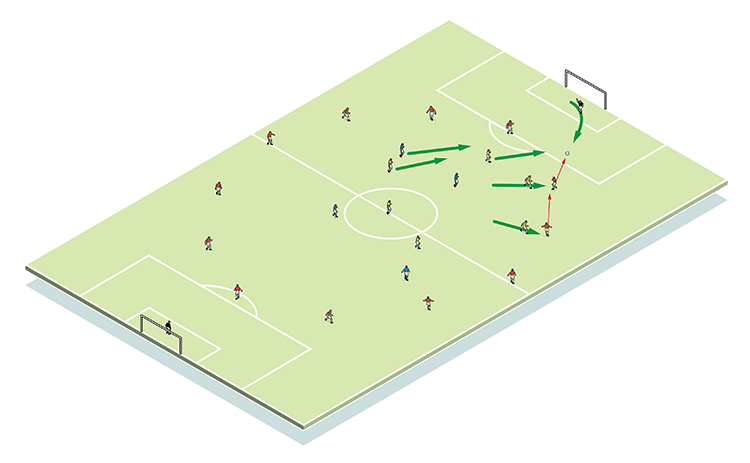
We recommend the same conditions as before, as well as now inviting teams to use either target man in their half. Target men can also link up between themselves, or the ball can be passed back to the keeper. He can then dribble across his box when looking for a team mate, or can simply play the ball out first time (3b). One defender can press the keeper.
3b
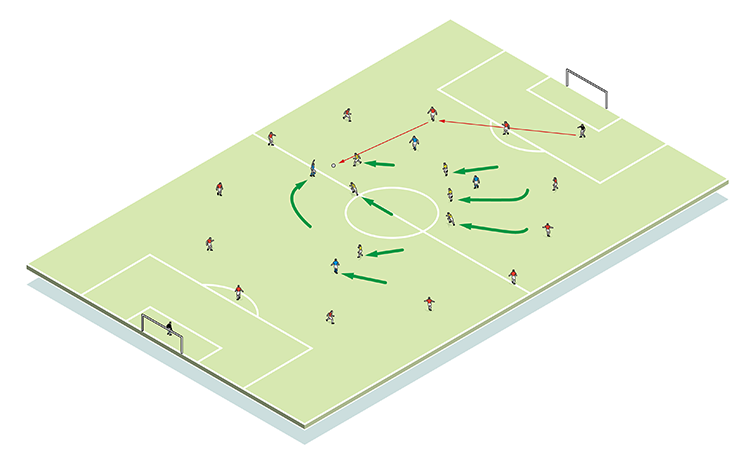
What are the key things to look out for?
There are four key areas for consideration:
Physical – the session is great for helping to maintain and top up players’ cardiovascular conditioning.
Technical – first-touch, awareness as to what’s on around players plus short and long passing is all practised. Good decision-making on the pass is also a key consideration.
Communication – concise information from players around the circle is important, while the pressing team must offer positive team guidance in closing down and restricting space.
Tactical – getting players to press in an effective manner is important. This could be in the form of the nearest man being the designated pressing player, with additional second- and third-man support. But the team should generally aim to force play one way, as well as making the perception of the circle as small as possible in order to limit options for the man on the
ball.
Related Files
Editor's Picks
Using the goalkeeper in build-up play
Pressing principles
Intensive boxes drill with goals
Penetrating the final third
Creating and finishing
My philosophy
Pressing initiation
Compact team movement
Defensive organisation
Coaches' Testimonials

Alan Pardew

Arsène Wenger

Brendan Rodgers

Carlos Carvalhal

José Mourinho

Jürgen Klopp

Pep Guardiola

Roy Hodgson

Sir Alex Ferguson

Steven Gerrard
Coaches' Testimonials

Gerald Kearney, Downtown Las Vegas Soccer Club

Paul Butler, Florida, USA

Rick Shields, Springboro, USA

Tony Green, Pierrefonds Titans, Quebec, Canada
Join the world's leading coaches and managers and discover for yourself one of the best kept secrets in coaching. No other training tool on the planet is written or read by the calibre of names you’ll find in Elite Soccer.
In a recent survey 92% of subscribers said Elite Soccer makes them more confident, 89% said it makes them a more effective coach and 91% said it makes them more inspired.
Get Monthly Inspiration
All the latest techniques and approaches
Since 2010 Elite Soccer has given subscribers exclusive insight into the training ground practices of the world’s best coaches. Published in partnership with the League Managers Association we have unparalleled access to the leading lights in the English leagues, as well as a host of international managers.
Elite Soccer exclusively features sessions written by the coaches themselves. There are no observed sessions and no sessions “in the style of”, just first-hand advice delivered direct to you from the coach.



